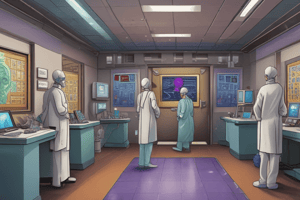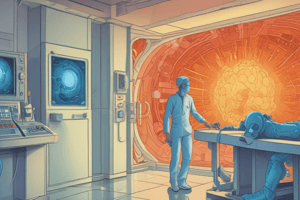Podcast
Questions and Answers
What is a significant advantage of PET/CT imaging in oncology?
What is a significant advantage of PET/CT imaging in oncology?
- It provides high spatial resolution images.
- It requires no ionizing radiation.
- It is less expensive than other imaging modalities.
- It shows function as well as anatomy. (correct)
Which type of contrast study is used to visualize blood vessels?
Which type of contrast study is used to visualize blood vessels?
- Angiography (correct)
- Hysterosalpingography
- Arthrography
- Barium studies
What does the acronym ALARA stand for in the context of radiology?
What does the acronym ALARA stand for in the context of radiology?
- As low as reasonably achievable (correct)
- As low as realistically achievable
- As low as radiologically achievable
- As low as recommended achievable
Which imaging modality is particularly indicated for the evaluation of the gastrointestinal tract?
Which imaging modality is particularly indicated for the evaluation of the gastrointestinal tract?
What is a major risk associated with the use of intravenous contrast material?
What is a major risk associated with the use of intravenous contrast material?
What is a characteristic drawback of nuclear medicine imaging methods?
What is a characteristic drawback of nuclear medicine imaging methods?
In what situation would fluoroscopy be preferred over traditional radiography?
In what situation would fluoroscopy be preferred over traditional radiography?
Which imaging technique is least likely to involve the use of ionizing radiation?
Which imaging technique is least likely to involve the use of ionizing radiation?
What is a significant advantage of using radiography as a medical imaging technique?
What is a significant advantage of using radiography as a medical imaging technique?
Which of the following imaging methods uses ionizing radiation?
Which of the following imaging methods uses ionizing radiation?
What is the primary purpose of medical imaging?
What is the primary purpose of medical imaging?
How are x-rays described in terms of their interaction with different tissues in the body?
How are x-rays described in terms of their interaction with different tissues in the body?
Which statement correctly describes the use of fluoroscopy?
Which statement correctly describes the use of fluoroscopy?
What distinguishes MRI from CT scans?
What distinguishes MRI from CT scans?
Which of the following best describes the use of different radiographic densities?
Which of the following best describes the use of different radiographic densities?
Why is pathologic assessment through radiology crucial?
Why is pathologic assessment through radiology crucial?
What does an increase in radiographic density indicate?
What does an increase in radiographic density indicate?
Which imaging techniques fall under interventional radiology?
Which imaging techniques fall under interventional radiology?
What is the minimum number of images required to effectively interpret a tibial fracture from different angles?
What is the minimum number of images required to effectively interpret a tibial fracture from different angles?
Which of the following statements is true about the differentiation of individual cardiac chambers on plain films of the chest?
Which of the following statements is true about the differentiation of individual cardiac chambers on plain films of the chest?
What is a key limitation of soft tissue differentiation using plain films in radiography?
What is a key limitation of soft tissue differentiation using plain films in radiography?
Which complication is NOT typically associated with angiography?
Which complication is NOT typically associated with angiography?
What is the primary reason that tissues appear in varying shades of grey on a CT scan?
What is the primary reason that tissues appear in varying shades of grey on a CT scan?
Which statement about the disadvantages of CT scans is correct?
Which statement about the disadvantages of CT scans is correct?
What does CT in medical imaging stand for?
What does CT in medical imaging stand for?
Which statement best describes the principle behind cross-sectional imaging in CT scans?
Which statement best describes the principle behind cross-sectional imaging in CT scans?
Which of the following best describes the difference between T1 and T2 MRI sequences?
Which of the following best describes the difference between T1 and T2 MRI sequences?
What is a significant benefit of using MRI over traditional radiographs?
What is a significant benefit of using MRI over traditional radiographs?
What is the primary purpose of fluoroscopy in medical imaging?
What is the primary purpose of fluoroscopy in medical imaging?
Which imaging plane divides the body into left and right sections?
Which imaging plane divides the body into left and right sections?
What role do radiopulses play in MRI technology?
What role do radiopulses play in MRI technology?
When viewing CT images, which statement correctly describes the orientation?
When viewing CT images, which statement correctly describes the orientation?
What is a common use of CT technology beyond structural imaging?
What is a common use of CT technology beyond structural imaging?
What is a significant advantage of using ultrasound for imaging?
What is a significant advantage of using ultrasound for imaging?
Which is not a common application of nuclear medicine?
Which is not a common application of nuclear medicine?
What does Doppler ultrasound primarily measure?
What does Doppler ultrasound primarily measure?
In the context of cardiac imaging, what is the purpose of myocardial scans?
In the context of cardiac imaging, what is the purpose of myocardial scans?
What does the presence of increased echogenicity in solid tissue indicate?
What does the presence of increased echogenicity in solid tissue indicate?
Which of the following statements about PET scans is accurate?
Which of the following statements about PET scans is accurate?
How does ultrasound imaging differ from CT in terms of bone imaging?
How does ultrasound imaging differ from CT in terms of bone imaging?
What type of pathology would a bone scan most likely be used to evaluate?
What type of pathology would a bone scan most likely be used to evaluate?
What is a limitation of using ultrasound imaging?
What is a limitation of using ultrasound imaging?
What kind of issues can a carotid ultrasound help investigate?
What kind of issues can a carotid ultrasound help investigate?
Flashcards are hidden until you start studying
Study Notes
Medical Imaging Overview
- Medical imaging aims to create visible images of the anatomy and function of the human body.
- Various imaging methods include X-rays, CT, MRI, ultrasound, PET, and nuclear medicine.
PET CT Imaging
- Uses tracers that undergo beta decay to visualize glucose metabolism.
- Bright or 'hot' areas indicate metabolic activity in the brain.
- PET/CT is crucial in oncology for analyzing tumors.
Nuclear Medicine
- Employs ionizing radiation but has poor spatial resolution.
- Can visualize both function and structure, especially important in cancer diagnosis.
Contrast Radiology Techniques
- Common methods include barium studies, angiography, and fluoroscopy.
- Various contrast agents are used, intravascularly or intratecally, to enhance imaging.
Risks of IV Contrast Agents
- Potential complications include extravasation, allergic reactions, nausea, and renal failure.
- The use of contrast should be carefully weighed against potential risks.
Patient Safety - ALARA Principle
- ALARA stands for "As Low As Reasonably Achievable," emphasizing minimal radiation exposure during imaging.
- Protocols must balance image quality with radiation dose.
Reducing Radiation Exposure
- Minimize unnecessary imaging, particularly repetitive exams in ICU settings.
- Prefer ultrasound (US) and MRI to reduce radiation risks associated with CT scans.
Imaging Techniques and Characteristics
- X-rays: High availability and low cost, but limited soft tissue contrast.
- CT scans: Provide cross-sectional images, excellent detail, but use high radiation doses.
- MRI: Uses magnetic fields to produce detailed images of soft tissues without ionizing radiation.
Imaging Principles
- X-rays create images by differentiating densities: gas appears dark while metal appears white.
- CT scans utilize Hounsfield Units to measure tissue attenuation and differentiate between tissue types.
Ultrasound Imaging
- Utilizes sound waves and poses no ionizing radiation risks.
- Valuable for real-time imaging and guidance for procedures.
Common Nuclear Medicine Procedures
- Bone scans identify metastatic disease; cardiac scans assess myocardial function; HIDA scans evaluate gallbladder function; thyroid scans monitor nodules.
MRI Sequences
- MRI can depict anatomical details (T1) and pathological conditions (T2).
- MRI provides superior soft tissue contrast, particularly useful for visualizing lesions.
Advantages and Disadvantages
- CT provides rapid, painless imaging and excellent detail but involves ionizing radiation and potential severe contrast reactions.
- MRI is safe regarding radiation exposure but requires specialized machines and can take longer to conduct.
Summary
- A selection of imaging methods exists, each with specific indications, contraindications, and potential side effects.
- Understanding the principles of imaging allows for informed decisions in clinical practice, optimizing the balance between diagnostic benefit and safety.
Studying That Suits You
Use AI to generate personalized quizzes and flashcards to suit your learning preferences.




